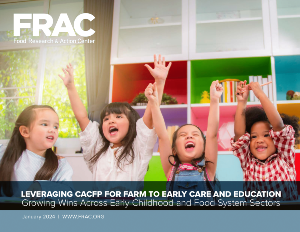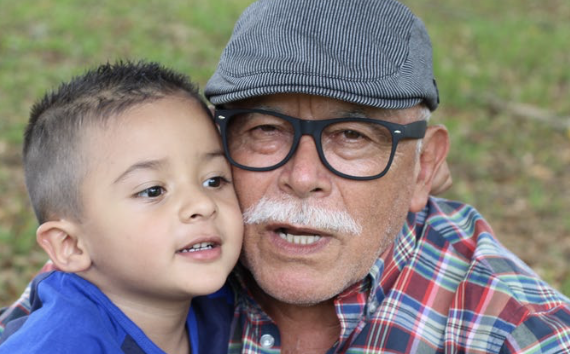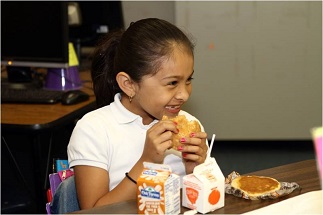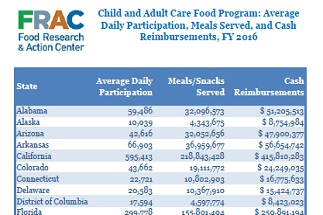
New Report: Leveraging CACFP for Farm to Early Care and Education: Growing Wins Across Early Childhood and Food System Sectors
FRAC’s latest report, produced with support from the W.K. Kellogg Foundation, outlines a pivotal cross-sector approach to improving children’s equitable access to fresh, nutritious foods to reduce hunger. Leveraging CACFP for Farm to Early Care and Education: Growing Wins Across Early Childhood and Food System Sectors provides recommendations and policy changes that support child care providers to access the federal Child and Adult Food Care Program (CACFP) and utilize it for eligible Farm to Early Care and Education (Farm to ECE) activities.

Toolkit: Maximizing the CACFP Area Eligibility Waiver for Family Child Care Homes
The Keep Kids Fed Act extends an area eligibility waiver allowing more family child care homes to receive the higher Tier 1 CACFP reimbursement rate. FRAC’s new communications toolkit is designed to help advocates inform family child care providers about this important resource that will help support their ability to reach and feed more children daily. The toolkit includes a model release, sample social media graphics and content, flyers, and email templates.

New Report Enhancing Young Children’s Access to Local Foods and Farm to ECE: Federal Funding Opportunities
The COVID-19 pandemic has had profound impacts across food and early care and education (ECE) systems that has exacerbated inequities and racial injustices in food, health, and education. While severely devastated by the COVID-19 pandemic and the subsequent economic crisis, the ECE sector and food and agriculture systems are ripe with opportunity to build back with greater equity and resiliency. Farm to early care and education (farm to ECE) can be a component of building back better.

Outreach Toolkit: New USDA Resources for Shelters Feeding Youth and Families Experiencing Homelessness
The American Rescue Plan (ARP) expanded access to meals for youth experiencing homelessness by allowing shelters to be reimbursed for meals served to children and young adults under 25 years old through the Child and Adult Care Food Program (CACFP). The usual age limit for meal reimbursement is through age 18. FRAC has developed a communications toolkit to help you spread the word and make the most of the expanded CACFP benefits.


Testimony: Reynaldo Green, National CACFP Forum President on the Child Nutrition Reauthorization
On March 25, 2021, Reynaldo Green testified before the Senate Committee on Agriculture, Nutrition, and Forestry, urging the committee to include CACFP priorities in the Child Nutrition Reauthorization Bill. Priorities included improving the adequacy of benefits by allowing another meal or snack for children in a full day of care, making proprietary care eligibility consistent with other federal nutrition programs by allowing yearly verification, and eliminating overly burdensome and outdated paperwork – in addition to our other important recommendations including increased reimbursement rates for providers and sponsors, improved area eligibility, and making permanent the expansion for homeless shelters.

Curious about the impact of COVID-19 on CACFP?
In March 2021, FRAC released a brief exploring the number of meals served through the program, reimbursements and costs, and the significance of this new data. Explore our three-page brief to learn more.

Food Research & Action Center’s Transition Recommendations: “This is the Time to Heal in America,” and It Begins With Addressing Hunger
FRAC’s transition recommendations provide a roadmap for the Biden-Harris Administration to address hunger in America. It sets forth the harms of food insecurity, summarizes the strengths of the federal nutrition programs, and concludes with high-priority recommendations for administrative and legislative asks that need to be taken to reduce hunger and poverty.

USDA Proposed New Rules Affecting CACFP: What you need to know
Watch the recorded webinar covering the two recently proposed USDA rules impacting the Child and Adult Care Food Program. Join USDA and FRAC to learn what you need to know about USDA’s proposed rules covering CACFP meal modifications, a request for input on allowing grain-based desserts in CACFP, and options for streamlining the application process for CACFP institutions to apply for the Summer Food Service Program.

New state Fact Sheets on Infant and Toddler Health from FRAC and the Think Babies™ Campaign
Are infants and toddlers in your state getting the nutrition they need for a healthy start in life? Find out with a new set of fact sheets released by the Food Research & Action Center and the Think Babies™ campaign.
CACFP supports good nutrition and quality care in early care and education settings. Check out these 17 CACFP best practices from across the country.
In FY 2018, CACFP provided 2 billion meals and snacks to:
- 4.5 million children daily in child care centers, family care homes, and afterschool programs.
- 66,000 child care centers.
- 131,000 persons in Adult Day Care.

Reducing CACFP Paperwork
State agencies, sponsors, advocates and other key stakeholders can use FRAC’s worksheet to evaluate current state policies, and identify opportunities for reducing paperwork requirements and barriers to participation.

CACFP Regulatory Roundup
Recent FRAC CACFP Comment Letters: Regulatory and Administrative Actions
- Delayed Implementation of Grains and Ounce Equivalents in the Child and Adult Care Food Program (July 31, 2019)
- Request for Information: The Serious Deficiency Process in the Child and Adult Care Food Program (August 6, 2019)
- Increasing Flexibility for Verification of For-Profit Center Eligibility in the Child and Adult Care Food Program (December 3, 2019)
Recent FRAC Nutrition Policy Comment Letters (CACFP Related)
- Dietary Guidelines for Americans: Comments on Topics and Questions (March 28, 2018)
- Proposed Objectives for Healthy People 2030 (January 17, 2019)

New USDA Rules for Meals and Snacks in the Child and Adult Care Food Program Go into Effect, Promote Healthy Eating Habits
As of October 1, 2017, all child and adult care centers and child care homes receiving federal funds from the Child and Adult Care Food Program (CACFP) must implement new nutrition standards that include a greater variety of vegetables and fruit, more whole grains, and less added sugar and saturated fat. The new standards also encourage breastfeeding and better align with WIC and other child nutrition programs, such as school breakfast and lunch.
CACFP pays for nutritious meals and snacks for eligible children who are enrolled at participating:
- Child Care Centers and Family Child Care HomesYoung children attending participating family child homes, child care centers, or Head Start programs can receive up to two meals and a snack that meet USDA nutritional standards. The majority of CACFP participants are preschool-aged children. Eligibility is based either on the poverty status of the area or on the income of the enrolled children.
- Afterschool ProgramsSchool-based afterschool programs providing enrichment activities for children and teenagers after school can also provide free snacks through CACFP in areas where at least 50 percent of children are eligible for free or reduced-price meals. CACFP funds also can pay for suppers for children attending afterschool programs.
- Homeless SheltersCACFP provides up to three meals a day for children age 18 and younger living in homeless shelters.
- Senior Day Care CentersCACFP provides meals and snacks to senior citizens attending nonresidential day care centers.
Trending

USDA Proposed New Rules Affecting CACFP: What you need to know
Watch the webinar
CACFP Changes Have Been Proposed in USDA Rule
Find out more
New Healthier CACFP Meal Standards: What you need to know
Watch the webinar
CACFP Participation Trends 2018 - New Report
Find out more
CACFP Fact Sheet
View the fact sheet
Child and Adult Care Food Program Participation Trends Brief
Read more
CACFP Meals Served, FY 2016
Download the chart
Improving Nutrition and Promoting Wellness in Child Care With CACFP
Read more
CACFP Enhanced Nutrition Standards Nutrition and Wellness State Agency Survey Results
See the survey
CACFP Nutrition and Wellness State Agency Survey Summary
Find out more
CACFP At-A-Glance
Benefits
Intervening in early childhood and providing high-quality child care programming is critically important in supporting the development of lifelong healthy behaviors. CACFP assures that low-income children in child care receive proper nutrition through ongoing training, technical assistance and support. In addition, by paying for nutritious meals and snacks for eligible children enrolled at participating child care centers and family child care homes, CACFP plays an important role in improving the quality of child care programs and in making them more affordable for low-income parents.Eligibility
To be eligible for participation in CACFP, a sponsor must be a licensed or approved child care provider or a public or nonprofit private school which provides organized child care programs for school children during off-school hours. Any child up to age 12 or adult attending a participating adult day care facility is entitled to meals. Programs eligible for participation include non-residential child or adult care institutions, such as group or family child care, child or adult care centers, Head Start, recreation centers, settlement houses, and afterschool programs. For-profit child care centers serving 25 percent or more low-income children are also eligible.Reimbursement
Participating programs are required to provide meals and snacks according to the nutrition standards set by USDA. The reimbursement rates vary based on the type of meal (lunches have a higher reimbursement rate than snacks), and the type of institution. Child and adult care centers and family child care homes have means-tested reimbursement systems that provide higher levels of reimbursement for low-income families: centers have a three-tiered and homes have a two-tiered reimbursement rate structure. See USDA Food and Nutrition Service’s CACFP Reimbursement Rates. At-risk afterschool programs and homeless, domestic violence and runaway shelters are assumed to be serving low-income children and are reimbursed at the highest rate.
Outreach Toolkit: New USDA Resources for Shelters Feeding Youth and Families Experiencing Homelessness
The American Rescue Plan (ARP) expanded access to meals for youth experiencing homelessness by allowing shelters to be reimbursed for meals served to children and young adults under 25 years old through CACFP. The usual age limit for meal reimbursement is through age 18. FRAC has developed a communications toolkit to help you spread the word and make the most of the expanded CACFP benefits.

